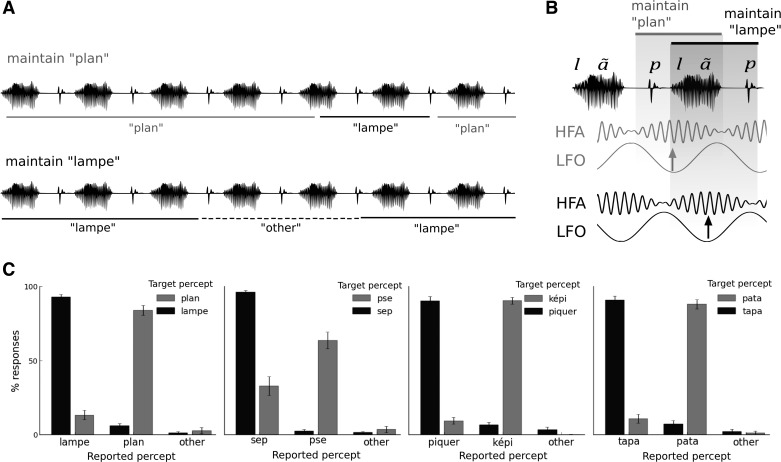Fig. 1.
Bistable speech segmentation: design (A), hypothesis (B), and behavioral reports (C). A: participants were asked to maintain a given percept a long as possible while listening to a bistable speech sequence. Four sequences of interest were presented: repetition of the word “lampe” ([lãp]), repetition of “sep” ([səp]), repetition of “képi” ([kepi]), and repetition of “pata” ([pata]). The sequences were bistable and could also be perceived as repetitions of the word “plan” ([plã]), “pse” ([psə]), “piquer” ([pike]), and “tapa” ([tapa]), respectively. Participants listened twice to each sequence and were asked to maintain either one or the other of the possible bistable speech percepts (e.g., maintain “plan” or maintain “lampe”). Subjects reported online their current percept by keeping a button pressed. Three buttons were given: two buttons for the bistable percepts (e.g., “plan” and “lampe”) and one button for “other” if subjects perceived another utterance. B: if low-frequency oscillations (LFO) reflect linguistic parsing mechanisms, we predicted that changes in the latency of speech tracking by LFO would define the boundaries of speech segmentation. In this example, for a given acoustic signal, the latency (indexed by the phase) of the low-frequency neural response was predicted to vary depending on whether participants perceive “plan” or “lampe”. Because the phase of low-frequency neural oscillations may modulate the excitability of high-frequency activity (HFA), changes in the latency of HFA were expected so that lowest HFA would be aligned with the word boundaries. C: on average, for any given speech sequence, participants succeeded in maintaining the instructed percept. Bars represent the proportion of responses when participants were asked to maintain the perception of one word during one sequence presentation (black) or the other word in another sequence presentation (gray). Errors bars denote SE.

